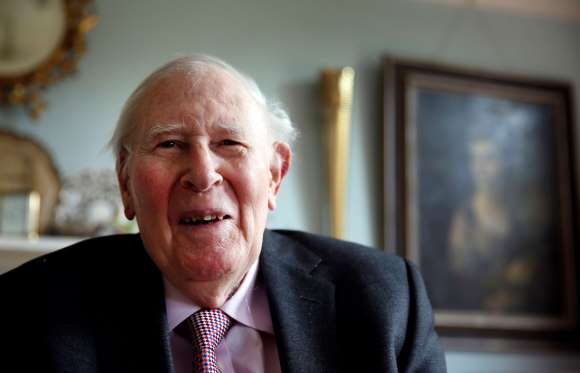March 4, 2018

March 4, 2018

LONDON — It was a typical British afternoon in early May: wet, cool and blustery. Not exactly the ideal conditions for running four laps around a track faster than many thought humanly possible.
A lanky Oxford medical student named Roger Bannister looked up at the white-and-red English flag whipping in the wind atop a nearby church and figured he would have to call off the record attempt.
But then, shortly after 6 p.m. on May 6, 1954, the wind subsided. Bannister glanced up again and saw the flag fluttering oh-so gently. The race was on.
With two friends acting as pacemakers, Bannister churned around the cinder track four times. His long arms and legs pumping, his lungs gasping for air, he put on a furious kick over the final 300 yards and nearly collapsed as he crossed the finish line.
The announcer read out the time:
"3…"
The rest was drowned out by the roar of the crowd. The 3 was all that mattered.
Bannister had just become the first runner to break the mythical 4-minute barrier in the mile — a feat of speed and endurance that stands as one of the seminal sporting achievements of the 20th century.
The black-and-white image of Bannister, eyes closed, head back, mouth wide open, straining across the tape at Oxford's Iffley Road track, endures as a defining snapshot of a transcendent moment in track and field history.
Bannister died peacefully in Oxford on Saturday at the age of 88. He was "surrounded by his family who were as loved by him, as he was loved by them," the family said in a statement Sunday. "He banked his treasure in the hearts of his friends."
British Prime Minister Theresa May remembered Bannister as a "British sporting icon whose achievements were an inspiration to us all. He will be greatly missed."
Bannister's time of 3 minutes, 59.4 seconds captured the world's imagination and buoyed the spirits of Britons still suffering through post-war austerity.
"It's amazing that more people have climbed Mount Everest than have broken the 4-minute mile," Bannister said in an interview with The Associated Press in 2012.
Bannister followed up his 4-minute milestone a few months later by beating Australia's John Landy in the "Miracle Mile" or "Mile of the Century" at the Empire Games in Vancouver, British Columbia with both men going under 4 minutes. Bannister regarded that as his greatest race because it came in a competitive championship against his fiercest rival.
While he will forever be remembered for his running, Bannister considered his long medical career in neurology as his life's greatest accomplishment.
"My medical work has been my achievement and my family with 14 grandchildren," he said. "Those are real achievements."
The quest to break the 4-minute mile carried a special mystique. The numbers were easy for the public to grasp: 1 mile, 4 laps, 4 minutes.
When Sweden's Gunder Hagg ran 4:01.4 in 1945, the chase was truly on. But, time and again, runners came up short. The 4-minute mark seemed like a brick wall that would never be toppled.
Bannister was undaunted.
"There was no logic in my mind that if you can run a mile in 4 minutes, 1 and 2/5ths, you can't run it in 3:59," he said. "I knew enough medicine and physiology to know it wasn't a physical barrier, but I think it had become a psychological barrier."
Bannister was born on March 23, 1929, in the London borough of Harrow. At the outbreak of World War II, the family moved to the city of Bath, where Bannister sometimes ran to and from school.
Bannister's passion for running took off in 1945 when his father took him to a track meet at London's White City Stadium, which was built to host the 1908 Olympics. They watched British middle-distance star Sydney Wooderson, who had emerged as a rival to the trio of Swedish runners who had taken the mile world record down close to the 4-minute mark.
"I made up my mind then when I got to Oxford, I would take up running seriously," Bannister said.
As a first-year student on an academic scholarship at Oxford, Bannister caught his coaches' attention while running as a pacemaker in a mile race on March 22, 1947. Instead of dropping out of the race as pacers normally do, he kept running and beat the field by 20 yards.
"I knew from this day that I could develop this newfound ability," he reflected in later life.
With the 1948 London Olympics approaching, Bannister was running mile times of around 4:10. The 19-year-old was selected as a "possible" for the British Olympic team, but decided he wasn't ready and focused on preparing for the 1952 Helsinki Games.
By then, Bannister was a full-time medical student and had to juggle his studies with his training. By modern standards, his daily half-hour workout was remarkably light.
Bannister was considered the favorite for the Helsinki gold in the 1,500 meters — the shorter metric mile distance run in the Olympics. Just before the games, he learned that organizers had added an extra round of heats, meaning he would have to run on three consecutive days.
With his rhythm thrown off, Bannister finished fourth in a final won by Josy Barthel of Luxembourg.
Had he won Olympic gold that day, Bannister almost certainly would have retired. But, criticized by the British media and disappointed in his own performance, he decided to keep running, dedicating himself to beating the 4-minute mile and winning gold at the `54 Empire Games.
By 1954, Hagg's record mile time had stood for nine years. Bannister, Landy and American miler Wes Santee were all threatening to break the mark and it became a matter of who would get there first.
"As it became clear that somebody was going to do it, I felt that I would prefer it to be me," Bannister said in an AP interview.
He also wanted to deliver something special for his country.
"I thought it would be right for Britain to try to get this," Bannister said in 2012. "There was a feeling of patriotism. Our new queen had been crowned the year before, Everest had been climbed in 1953. Although I tried in 1953, I broke the British record, but not the 4-minute mile, and so everything was ready in 1954."
Bannister scheduled his attempt for May 6 during a meet between Oxford and the Amateur Athletic Union. He started the day at the St. Mary's Hospital lab in London, where he sharpened his spikes and rubbed graphite on them so they wouldn't pick up too much of the track's cinder ash. He took a midmorning train from Paddington Station to Oxford.
The weather was dank and miserable. Bannister's Austrian coach, Franz Stampfl, told him this might be his best chance. When the flag started to billow gently, he decided it was now or never.
"I calculated there's a 50-50 chance of my doing it," Bannister recalled. "I said, `If there's a 50-50 chance and I don't take it, I may never get another chance to beat Landy to it.' So I said, `Let's do it.'"
Bannister had lined up English runners Chris Brasher and Chris Chataway as pacemakers. Brasher, a steeplechaser, ran the first lap in 58 seconds and the first half-mile in 1:58. Chataway moved to the front and took them through three laps in 3:01. Bannister would have to run the final lap in 59 seconds.
He surged in front of Chataway with about 300 yards to go.
"The world seemed to stand still, or did not exist," Bannister wrote in his book "The First Four Minutes." "The only reality was the next 200 yards of track under my feet. The tape meant finality — extinction perhaps. I felt at that moment that it was my chance to do one thing supremely well. I drove on, impelled by a combination of fear and pride."
Bannister crossed the line and slumped into the arms of a friend, barely conscious. The chief timekeeper was Harold Abrahams, the 100-meter champion at the 1924 Paris Olympics whose story inspired the film "Chariots of Fire." He handed a piece of paper to Norris McWhirter, who announced the time.
The record lasted just 46 days. Landy ran 3:57.9 in Turku, Finland, on June 21, 1954. (The current record stands at 3:43.13, held by Morocco's Hicham El Guerrouj since 1999.)
That set the stage for the head-to-head showdown between Bannister and Landy on Aug. 7, 1954, at the Empire Games, now called the Commonwealth Games, in Vancouver.
Always a front-runner, Landy set a fast pace, leading by as much as 15 yards before Bannister caught up as the bell rang for the final lap. When the Australian glanced over his left shoulder on the final bend to check where Bannister was, the Englishman raced past him on the right and won by about four yards in 3:58.8. Landy clocked 3:59, the first time two men had run under 4 minutes in the same race.
Bannister capped his amazing year by winning the 1,500 meters at the European championships in Bern, Switzerland, in 3:43.8, his third major achievement in the span of a few months.
"Each one proved something different," he said. "Each one was necessary."
Sebastian Coe, president of the IAAF, the athletics governing body, said Bannister's death represented a "day of intense sadness both for our nation and for all of us in athletics."
Coe ran a mile in a then-world record time of 3 minutes, 47.33 seconds in 1981, between winning gold medals at 1,500 meters at the 1980 and 1984 Olympics.
"There is not a single athlete of my generation who was not inspired by Roger and his achievements both on and off the track," the Briton tweeted Sunday.
Bannister, who was chosen Sports Illustrated's first Sportsman of the Year in 1954, retired from competition and pursued a full-time career in neurology. As chairman of Britain's Sports Council between 1971 and 1974, he developed the first test for anabolic steroids.
Bannister also served as master of Oxford's Pembroke College from 1985-93. In 2012, he edited the ninth edition of a textbook on nervous-system disease and said his most treasured trophy was the lifetime achievement award he received in 2005 from the American Academy of Neurology. He was knighted for his medical work in 1975.
"I wouldn't claim to have made any great discoveries, but at any rate I satisfactorily inched forward in our knowledge of a particular aspect of medicine," he said. "I'm far more content with that than I am about any of the running I did earlier."
Bannister was slowed in later years by Parkinson's, a neurological condition that fell under his medical specialty.
His right ankle was shattered in a car accident in 1975, and he had been unable to run since then. In his late life, he walked with crutches inside his home and used a wheelchair outdoors.
Bannister made several public appearances as part of the 2012 London Olympics. He carried the flame on the Oxford track where he broke the 4-minute mile during the torch relay and attended the final of the men's and women's 1,500 meters at the games.
"I feel I never really left," he told the AP as he watched the action in the Olympic Stadium.
Bannister married Moyra Jacobsson, an artist, in 1955. They had two sons and two daughters and lived in a modest home only minutes away from the track where he made history.
Brasher, who founded the London Marathon, died in 2003 at the age of 74. Chataway died in 2014 at 82.
Courtesy/Source: AP
















































































































